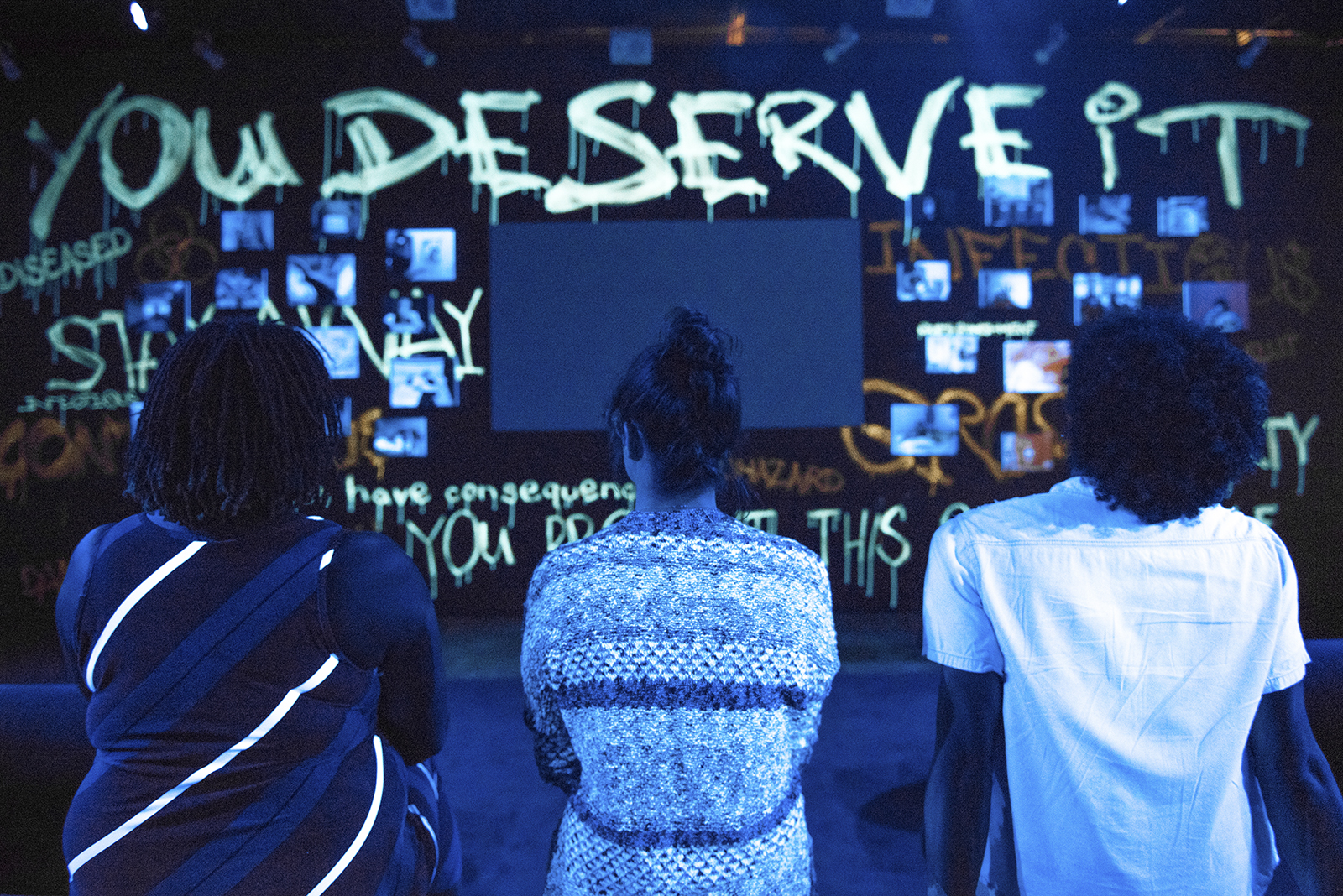Fowler exhibit works to break stigma surrounding HIV, AIDS through art

The Fowler Museum’s exhibit “Through Positive Eyes” features live story telling and art done by people who are HIV-positive. David Gere, a professor in the World Arts and Cultures department, said giving the HIV-positive people the power to create their own art makes it more meaningful, as they can project their own experiences into their work rather than relying on others. (Kanishka Mehra/Assistant Photo editor)
"Through Positive Eyes"
Through Feb. 16
Fowler Museum
Free
By Deirdre Klena
Oct. 2, 2019 11:37 p.m.
Visitors are greeted with a wall of the faces of 130 HIV-positive people at the Fowler Museum at UCLA’s newest installment.
The “Through Positive Eyes” exhibit will be on display at the Fowler through Feb. 16, featuring live storytelling and art by people who are HIV-positive. Photographs taken by the artists will be displayed and accompanied by text and videos to tell stories about their experiences living with the virus. David Gere, a professor in the World Arts and Cultures/Dance department, said the project started over 10 years ago with the work of Gideon Mendel, a South African photographer who had been chronicling the AIDS crisis in sub-Saharan Africa.
“What we devised, we hope, is an opportunity for people living with HIV to do the art themselves,” Gere said. “To share their own photographs, to share their own stories, to do this in the first person so that it feels as immediate as possible, so that it breaks through the bonds of stigma.”
Mendel’s work originally involved photos of HIV-positive people accompanied by text that relayed the subjects’ stories, Gere said. But eventually, he realized that giving those affected by HIV the camera to tell their own stories would be even more powerful. Someone photographing and following those living with HIV can be disempowering – as they lose control of their own story – and invasive.
However, giving them the resources to do it themselves allows them to tell their own stories in their own way, said alumna and “Through Positive Eyes” project coordinator Kelly Gluckman.
“These are individuals with their own rich histories and their own things to talk about, so why don’t we ask them to go document their lives and then we can help them curate their own images into a story,” Gluckman said.
[RELATED: Dance Marathon performer talks living with HIV, changing stigma surrounding it]
Before the exhibit reached its current form, Gere said teams of students would interview people with HIV and write up their testimonies. Later realizing the method was ineffective in truly revealing their experiences, Gere decided to encourage those living with HIV to document their own personal stories instead of relying on others to do so. The people they would have interviewed were then given cameras and photography training so they could document stories through their own personal lens, Gluckman said.
This is not the first time the Fowler has worked with the subjects of HIV and AIDS. The Fowler has a long history of displaying art and exhibitions related to HIV and AIDS, said Amy Landau, the Fowler’s director of education and interpretation. Landau said the museum creates a space for dialogue to foster conversations about HIV and AIDS advocacy. With “Through Positive Eyes,” this is most evident in the “Vanishing Stigma” room where live performances promote active conversations between visitors and the artists.
“The Fowler has had this wonderful history of looking within and exploring how there can be these inclusive and polyphonic spaces for these conversations,” Landau said.
[RELATED: Alumni’s short film questions intersection of art, social activism]
In addition to the photographs and videos, there is an art installation by Los Angeles artist Alison Saar, who is an HIV-negative ally, said Allison Clark, the assistant director of education at the Fowler. Saar’s evocative artwork in conjunction with the deeply personal photographs and videos paint a picture of the experience of living with HIV and AIDS, Landau said.
The piece, revived from 30 years ago, included cut marks and holes meant to invoke Karposi’s sarcoma lesions that were a visible symptom of HIV and AIDS at the time. However, they have since been transformed in this version to look like scars, representing the healing that has begun to take place, Clark said.
“This most recent iteration has a different vantage point, so instead of highlighting uncertainty, it’s really highlighting all of the accomplishments that people have been able to achieve in the last 30 years,” Clark said.
An important emphasis of the exhibit is the reduction of stigma surrounding HIV and AIDS, Gere said. The images and stories of people living with HIV provoke compassion and understanding from viewers. These feelings can be accomplished through education and the ability to consider the broad range of those affected by HIV, Gluckman said. This allows them to feel more connected to the HIV community through a broader understanding, she said.
“Stigma’s the hardest part of my journey as a person living with HIV,” Gluckman said. “I feel like getting to know the human beings behind this silly virus is gonna change hearts and minds and educate people.”
Human connection and compassion are the key players in reducing stigma, Gere said. Viewers are meant to experience intimacy once they have finished walking through the exhibit and have had time to meditate on what they’ve seen and speak directly with the people living with HIV. The conversations between visitors and those living with HIV are often where breakthroughs occur and where the most impactful connections are made, he said.
“To pause for a moment, shake a hand, give a hug, receive a hug, have direct contact with someone who’s living with HIV so they can never say again, ‘I don’t know anybody who has HIV’ because you do,” Gere said.

